CBSE Class 10: How Quadratic Equations Can Help You Make A Shot In Basketball
CBSE Class 10th Exam Date:01 Jan' 26 - 14 Feb' 26
Quadratic equations are more than just mathematical concepts; they are the hidden architects behind the mesmerising art of making the shot during a basketball game. As you step into the world of quadratic equations in your CBSE Class 10 mathematics curriculum, you'll find these equations to be fundamental building blocks that unveil the science behind a simple basketball shot. This article will be your guide to unravelling the connection between quadratic equations and the elegant trajectory of a basketball in flight.
This Story also Contains
- Understanding Quadratic Equations: The Basics
- Methods to Solve Equations
- Quadratic Equation Solver
- Discriminant and Root Classification
- Quadratic Equation Graphs
- From Equations to Basketball: The Trajectory of a Shot
- The Quest for the Perfect Shot

Understanding Quadratic Equations: The Basics
Before we delve into the world of basketball, let's revisit the basics of quadratic equations.
A quadratic equation is a second-order polynomial equation containing a single variable $x$.
It typically looks like this: $a x^2+b x+c=0$
Here, $x$ is the variable, and $a, b,$ and $c$ are constants. It is important to note that $a$ should not be equal to 0. The solutions to this equation are the values of $x$ that satisfy the equation and make it equal to zero. These solutions are known as the "roots" of the quadratic equation.
Methods to Solve Equations
Solving quadratic equations is like solving a puzzle. Sometimes, the equation can be factored easily, while at other times, you need a more sophisticated approach, such as completing the square or using the quadratic formula. Let's discuss these three techniques in detail.
Factoring Method
Factoring means expressing the quadratic equation as a product of two simpler expressions (binomials). Think of it as taking apart a Lego structure to see its smaller pieces.
Here's how it works:
Step 1: Start with the equation: $a x^2+b x+c=0$
Step 2: Identify $a, b$, and $c$.
Step 3: Find two numbers that multiply to $a \times c$ and add up to $b$.
Step 4: Split the middle term (bx) using those two numbers.
Step 5: Factor by grouping.
Step 6: Set each factor equal to zero to find $x$.
Let's see an example:
Equation: $x^2+5 x+6=0$
- ${a}=1, {~b}=5$, and ${c}=6$
- Numbers that multiply to ' $1 \times 6$ ' and add up to 5 are 2 and 3.
- Rewrite $5x$ as ' $2 {x}+3 x$ '.
- Factor: $(x+2)(x+3)=0$
Now, set each factor equal to zero:
$
\begin{aligned}
& x+2=0 \Rightarrow x=-2 \\
& x+3=0 \Rightarrow x=-3
\end{aligned}
$
So, the solutions are $x=-2$ and $x=-3$.
Completing the Square
This method transforms a quadratic equation into a perfect square form. It’s slightly longer but extremely useful when factoring doesn’t work.
Here's how it's done:
-
Start with the quadratic equation in the form: $ax^2+bx+c=0$
-
Divide the entire equation by $a$ to make the coefficient of $x^2$ equal to 1.
-
Move the constant term ($\frac ca$) to the other side of the equation.
-
Add and subtract the square of half of the coefficient of the $x$ term $\frac{b}{2 a}$.
The equation will then be in the form: $\left(x+\frac{b}{2 a}\right)^2=d$
Solve for $x$ to find the solutions.
Let's go through an example:
Equation: $x^2-6 x+8=0$
- Divide by $a$: $x^2-6 x+8=0$
- Move constant term: $\mathrm{x}^2-6 \mathrm{x}=-8$
- Add and subtract $(-\frac62 \times 1)^2= 9$
$
\begin{aligned}
& x^2-6 x+9=-8+9 \\
&\Rightarrow(x-3)^2=1
\end{aligned}
$
Now, take the square root of both sides:
$
\begin{aligned}
& x-3=\sqrt{ 1} \\
& \Rightarrow x-3= \pm 1
\end{aligned}
$
Solutions: $x=3 \pm 1$ that is $x=4$ and $x=2$
Quadratic Formula
When the equation isn’t easily factorable, the Quadratic Formula always works, as it is an effective method for students.
The formula goes as follows:
$x=\frac{-b \pm \sqrt{b^2-4 a c}}{2 a}$
Where:
$a=$ coefficient of $x^2$
$b=$ coefficient of $x$
$c=$ constant term
$\sqrt{b^2-4 a c}$ is called the discriminant
In this formula, $a, b,$ and $c$ are the coefficients from the original quadratic equation. The "±" symbol represents the two possible solutions, and the square root calculates the discriminant, which gives us insights into the nature of the roots.
In summary:
-
Use Factoring for simple, clean quadratics.
-
Use Completing the Square to understand structure and symmetry.
-
Use the Quadratic Formula when nothing else works, as it is universal.
Also, read,
Smart Shopping CBSE Class 8: Comparing Quantities For Better Deals
Quadratic Equation Solver
Students can use the following link to solve and find the roots of quadratic equations in the form $ax^2+bx+c=0$. Values up to 12 can be checked there. Students can also plot the graph of the quadratic function and examine it at up to four different points. Additionally, the calculator displays key properties such as the discriminant, vertex coordinates, and the sum and product of roots, helping you understand how each coefficient affects the shape and position of the parabola.
Click on this link to use the Quadratic Equation Solver
For example:
Graph of $3x^2+4x+1=0$
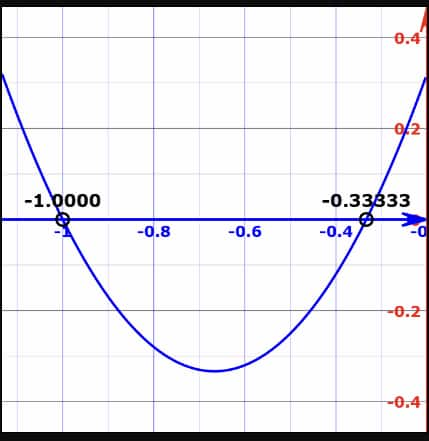
Roots are: $-1$ and $-0.33333$
Discriminant and Root Classification
The discriminant (Δ) of a quadratic equation plays a crucial role in categorising its roots. The formula to calculate the discriminant is: Δ = $b^2-4 a c$
Based on the value of Δ, we can determine the nature of the roots:
-
If Δ > 0, the equation has two distinct real roots.
-
If Δ = 0, the equation has a single real root (a repeated root).
-
If Δ < 0, the equation has two complex conjugate roots.
Understanding the discriminant helps us predict the behaviour of the equation without actually solving it.
Quadratic Equation Graphs
Graphs are powerful visual representations that provide insights into the behaviour of quadratic equations. By analysing the shape and key points of these graphs, we can understand how different coefficients and constants in quadratic equations affect their curves.
Let's explore the graphs of quadratic equations in various cases.
Case 1: [When $a$ is Positive]
When $a$ is positive, the graph of the quadratic equation opens upwards. This means the parabola has a minimum point. The larger the value of $a$, the narrower the parabola.
Example: $y=x^2$
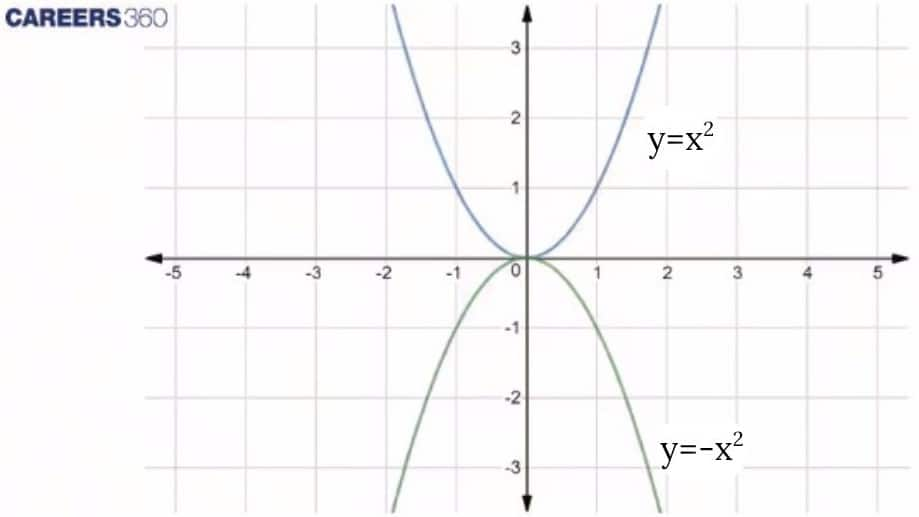
Case 2: [When $a$ is Negative]
When $a$ is negative, the graph of the quadratic equation opens downwards. The parabola has a maximum point. Again, the smaller the value of $a$, the wider the parabola.
Example: $y=-x^2$
Case 3: [When$b$ is Positive or Negative]
The coefficient $b$ determines the horizontal shift of the parabola. If $b$ is positive, the parabola shifts to the left, and if $b$ is negative, it shifts to the right.
Examples:
-
Positive $b$: $y=x^2-2 x$
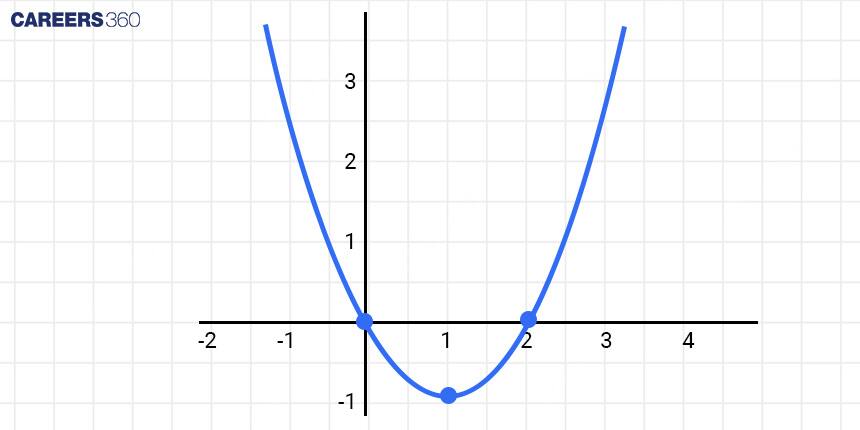
-
Negative $b$: $y=x^2+2 x$
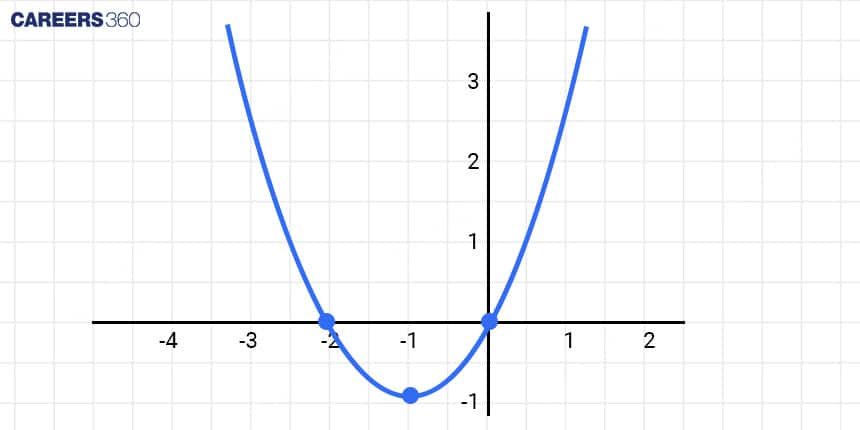
Case 4: [Discriminant and Nature of Roots]
The discriminant (Δ) of a quadratic equation affects the number and nature of its roots. We can visualise this on the graph.
Δ > 0: Two real and distinct roots. The parabola intersects the x-axis at two points.
Δ = 0: One real repeated root. The parabola touches the x-axis at one point.
Δ < 0: Two complex conjugate roots. The parabola does not intersect the x-axis.
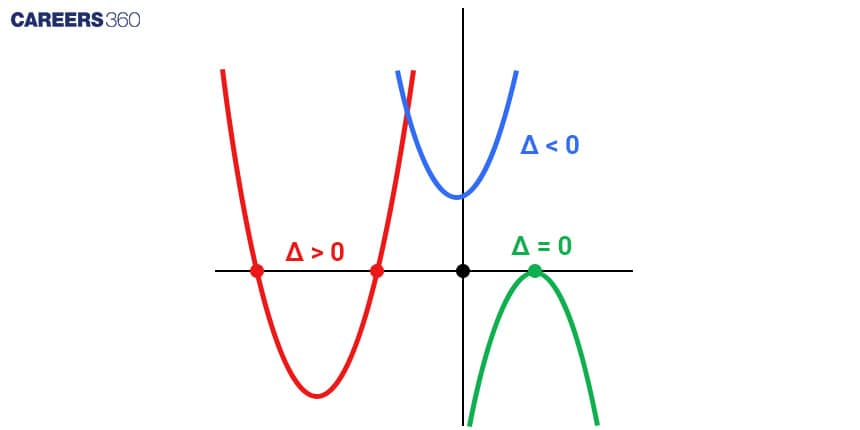
From Equations to Basketball: The Trajectory of a Shot
Now, let's transition from mathematics to the basketball court. When a basketball player takes a shot, the ball's path follows a curved trajectory. This trajectory is a result of the shot's initial velocity and the force of gravity pulling the ball downwards. This curving path is aptly described by quadratic equations.
Mathematics enables us to break down the elements of a basketball shot.
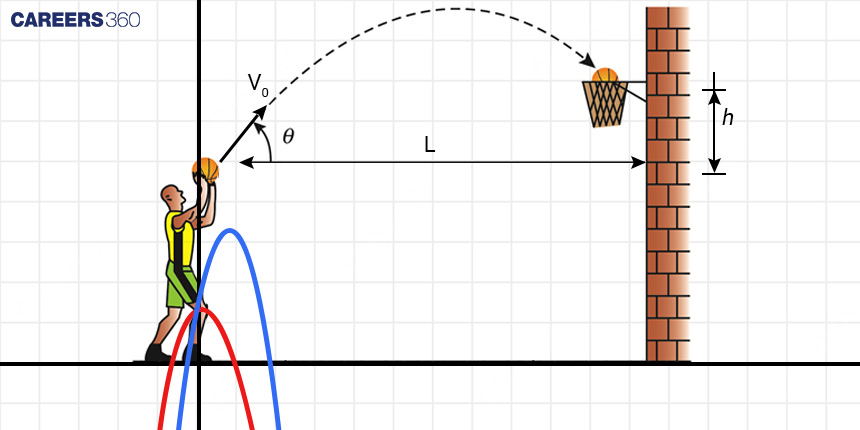
General Vertical Motion (with downward parabola)
Since the parabola opens downward, $a<0$. The vertical position $y$ of a ball over time $t$ can be written as:
$y=-\frac{1}{2} g t^2+v_0 \sin \theta t+h_0$
where:
$g=$ acceleration due to gravity
$v_0=$ initial velocity
$\theta=$ angle of projection
$h_0=$ initial height
Horizontal Motion
$x=v_0 \cos \theta t$
Trajectory Equation (eliminating t)
$y=x \tan \theta-\frac{g x^2}{2\left(v_0 \cos \theta\right)^2}+h_0$
Other form (if using feet and $g=32\ \mathrm{ft} / \mathrm{s}^2$)
$y=-16 t^2+v_0 \sin \theta t+h_0$
Must, Check,
Why You Should Give Mock Tests Even For Banking Exams?
The Quest for the Perfect Shot
A basketball player's ultimate goal is to nail the perfect shot – a shot that sails through the hoop with finesse. Achieving this requires understanding the interplay between the initial velocity $v$ and the angle of release. Quadratic equations hold the key to determining the parabolic arc that the ball will follow.
Different angles and velocities lead to various trajectories. By tinkering with these variables, players can fine-tune their shots. Quadratic equations help them comprehend the mechanics behind their shots and make informed decisions to enhance their accuracy.
Consider a basketball player who is aiming for a hoop placed at a height of 15 feet. The player of height 5 feet wants to shoot the ball at an angle of 45 degrees and an initial velocity of 50 feet per second. How far from the hoop should the player stand to make the shot?
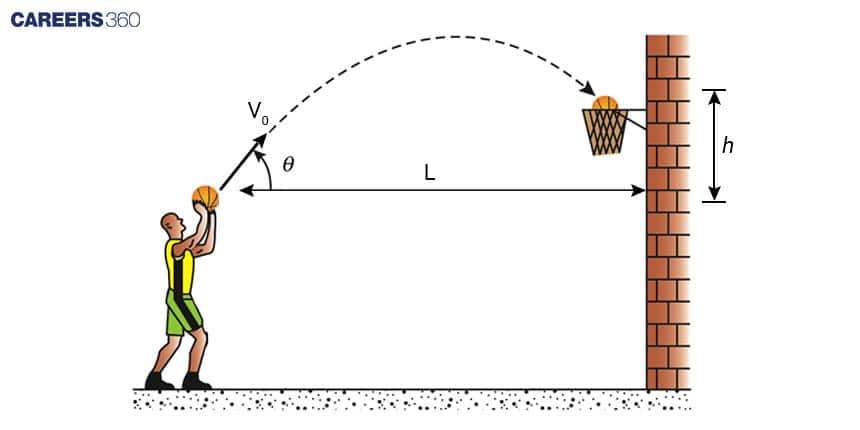
let's break down the key components of the problem:
-
Initial angle of release $(θ)$: 45 degrees
-
Initial velocity $(v_0)$: 50 feet per second
-
Height of the hoop $(h)$: 15 feet - 5 feet = 10 feet (above the person)
-
Acceleration due to gravity (g): 32 feet/ s2
(negative since it's acting downward)
Quadratic equation for basketball written as
$y=-16 t^2+v_0 \sin \theta t+h_0$
After time t, the ball will reach the basket height:
$\begin{aligned} & -16 t^2+\frac{50}{\sqrt{2}} t-10=0 \\ & ⇒-16 t^2+35.36 t-10=0\end{aligned}$
Using the formula: $t=\frac{-b \pm \sqrt{b^2-4 a c}}{2 a}$
Here: $a=-16, b=35.36, c=-10$
$t=\frac{-35.36 \pm \sqrt{(35.36)^2-4(-16)(-10)}}{2(-16)}$
$⇒t=\frac{-35.36 \pm \sqrt{1250.4-640}}{-32}$
$⇒t=\frac{-35.36 \pm \sqrt{610.4}}{-32}$
$⇒t=\frac{-35.36 \pm 24.71}{-32}$
Only positive time is meaningful:
So, $t=1.87$ seconds
Now, Horizontal distance, $x=v_0 \cos \theta t=50 \cos 45^{\circ}(1.87)=35.36 \times 1.87 \approx 65.85 \mathrm{ft}$
So, the basketball player should stand approximately 65.85 feet from the hoop to make a successful shot with an angle of 45 degrees and an initial velocity of 50 feet per second.
Understanding quadratic equations empowers players to adapt to different court positions, distances, and angles. Armed with this knowledge, players can adjust their shots dynamically, improving their overall accuracy and consistency.
Also, read,
Frequently Asked Questions (FAQs)
Quadratic equations help predict and analyse the parabolic motion of the ball, which is essential for accuracy in shooting, passing, or training.
Basketball is used in Maths in many ways.
Trajectory & Shooting: Quadratic equations model the ball’s parabolic path to calculate time and distance.
Angles & Speed: Trigonometry helps determine the best shooting angle and velocity.
Scoring & Statistics: Arithmetic and percentages track player stats and team performance.
Game Strategy: Probability and data analysis optimise plays and decision-making.
Knowledge of projectile motion helps you shoot baskets by showing the ball’s parabolic path. It helps choose the right angle and speed, and predicts where the ball will land, improving accuracy.
Here are some Real-life examples of quadratic equations.
Projectile motion: Throwing a ball, basketball shots, or a javelin follows a parabolic path.
Area problems: Finding the dimensions of a rectangular garden or room given the area and perimeter.
Economics & Business: Calculating profit or revenue, where profit = revenue – cost.
Physics: Modelling free fall or motion under gravity.
Engineering: Designing bridges, ramps, or arches that follow a parabolic shape.
Shooting 50-40-90 in basketball means a player has an excellent shooting performance: 50% field goal accuracy, 40% three-point accuracy, and 90% free throw accuracy. It’s considered an elite shooting benchmark.
Questions related to CBSE Class 10th
On Question asked by student community
Good Morning, candidate,
The question papers will be available soon at the link attached herewith. You can keep an eye on the website of careers360. it will provide you perfect pattern of question papers, which will improve your writing skills and practice learning.
https://school.careers360.com/articles/cbse-sahodaya-class-10-pre-board- question-paper-2025-26
Thank you.
Hello,
You can download subject wise CBSE Sahodaya Class 10 Pre-Board Question Paper 2025-26 for Round 1 & Round 2 from this link : CBSE Sahodaya Class 10 Pre-Board Question Paper 2025-26
Hope it helps !
Hello there,
Solving question papers is one of the best method of preparation. It gives you proper idea about the exam pattern and important topics to cover.
Here is the link attached from the official website of Careers360 which will provide you with the CBSE Sahodaya question papers. Hope it helps!
https://school.careers360.com/articles/sahodaya-question-paper-2025
thank you!
The CBSE Class 10 Hindi Question Paper Blueprint (Marking Pattern) for the 2025-2026 Board Exam is divided into four main sections, with a total of 80 marks for the written exam. The structure is slightly different for Hindi Course A and Hindi Course B.You can download the official Sample Question Paper (SQP) and its Marking Scheme for both Hindi Course A and Course B here: https://school.careers360.com/boards/cbse/cbse-class-10-hindi-sample-papers-2025-26
The CBSE Sahodaya Question Papers for Class 10 (2025-26) are not released centrally by the board as a single PDF.
Here is the essential information you need:
-
Local Release: The papers are designed and released by the individual Sahodaya School Clusters (groups of CBSE schools) just before or during the pre-board exam dates (typically held in December and January). Therefore, you must check your local cluster's portal or directly with your school administration.
-
Best Practice: The official model papers, based on the full 2026 syllabus, are the most reliable tool for practice. These accurately reflect the structure, format, and competency-based questions used in the Sahodaya exams.
You can download the latest CBSE Class 10 Model Papers to simulate the Sahodaya tests here: https://school.careers360.com/articles/sahodaya-question-paper-2025 . Focus on that pattern
Applications for Admissions are open.
As per latest syllabus. Physics formulas, equations, & laws of class 11 & 12th chapters
JEE Main Important Chemistry formulas
Get nowAs per latest syllabus. Chemistry formulas, equations, & laws of class 11 & 12th chapters
JEE Main high scoring chapters and topics
Get nowAs per latest 2024 syllabus. Study 40% syllabus and score upto 100% marks in JEE
JEE Main Important Mathematics Formulas
Get nowAs per latest syllabus. Maths formulas, equations, & theorems of class 11 & 12th chapters
